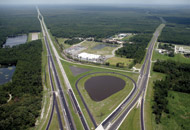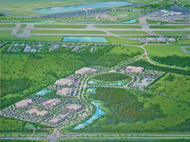|
COVER STORY, SEPTEMBER 2008
INDUSTRIAL GOLDMINE
Economic Development Case Study: Volusia County, Fla., finds wealth and jobs in shovel-ready industrial parks.
Jon Ross
Volusia County is an area rife with possibilities for industrial growth. Cutting a wide swath through Northern Florida, from Daytona Beach on the eastern coast to Altamonte Springs in the southwest, Volusia County encompasses 16 cities and the confluence of two large interstates. More than 400 manufacturers in the auto component, medical product, marine recreational and aviation industries call the county home, and each year 5,000 to 6,000 people move to the area from downstate. But with Orlando a short jaunt to the south, county officials have seen a steady commuter trickle down Interstate 4 slowly turn into a flood.
In 2002, Volusia County officials decided to do something about the close to 60,000 workers who leave for Orlando each morning. Historically, manufacturers in the county have been restricted to industrially-zoned buildings and had no chance to expand in an industrial park atmosphere. Officials reasoned that if the county could somehow attract businesses, residents wouldn’t need to commute elsewhere for work. To address the problem, the Department of Economic Development was formed and the quest to retain skilled citizens began. The first step was to create infrastructure.
“We realized very quickly that we didn’t have any entitled sites that people get a building permit and build a building,” says John Wickert, who served as the county’s economic development director from 2002-2006. “We had buildings, but we didn’t have any spec buildings that someone could just move into.”
Soon after starting the job, Wickert learned that in order to bring businesses to the area and keep jobs in the county, someone had to build properties firms could easily occupy.
“A business relocating—they want to take as little risk as possible,” Wickert says. “Any time that you can shorten time frames for risk or provide shovel-ready sites that are permitted, you’re saving time and money.”
It hasn’t all been as simple as laying a foundation and watching businesses pour in. Because of environmental and zoning restrictions, developers usually face an uphill battle when bringing projects to Florida. If businesses had moved down wanting to build a place, it might have taken as many as 12 to 18 months just to permit the space. This could have been easily overcome with some foresight and research. Developers also faced a ballooned cost of land.
“A lot of the land you buy, maybe it’s agriculturally zoned, but it’s priced at improved value for highest and best use,” says Rick Michaels, who took over as economic development director in 2006.
The presence of I-4 and I-95 seemed like a sign that Volusia County should expand its industrial base. The existing manufacturers had already benefited from easy access to the interstates, which cut across Florida and up and down the East Coast. These manufacturers had conglomerated in small patches zoned for industrial use that were spread throughout the area. For Wickert, creating full-fledged industrial parks was uncharted territory.
“We’ve never had an industrial park that was started from scratch of any magnitude,” he says. “We have industrial areas, but it’s a street that’s zoned industrial with six buildings that were built by six different people.”
Wickert and his team of economic advisors created a 5-year strategic plan that addressed, among other things, how to attract growth in Volusia County. The process began by selecting large sites throughout the area that were located near the interstates and had the acreage to support an industrial park. The strategic plan outlined everything involving the property, from securing the land to permitting the buildings.
 |
DeLand Crossings in DeLand, Fla.
|
|
For the first development, the team zeroed in on 43 acres nestled between I-4 and S.R. 44 in DeLand, Fla. To fund the space, the economic development department had to coordinate with all three branches of government. In the end, DeLand Crossings, which was completed in 2006, was built to house 300,000 square feet of industrial space that will provide 300 jobs for DeLand residents.
After permitting the site and arranging for the infrastructure, the team went about securing tenants. NSI Intellitech was the first company to move in, occupying a 64,000-square-foot tilt-wall facility. The California company BBK Performance Parts, a firm that produces after-market car accessories, soon followed, reserving a 62,000-square-foot Class A manufacturing space, which will deliver in December. Together, the two companies will bring nearly 90 jobs to the local economy.
 |
Daytona Beach International Airport’s Corporate Center is expected to generate 2,500 jobs for Volusia County residents.
|
|
For the next project, the team moved north to Daytona Beach for the 95-acre Daytona Beach International Airport Corporate Center. Engineering on the center started early this year, and construction is planned for 2009. One tenant, a high-tech defense simulation company, has already expressed interest in building a 180,000-square-foot property for research and development. The park is expected to attract $100 million in investment and 2,500 workers.
The county also is developing a project on 53 acres in Ormond Beach, and a Virginia-based tenant has expressed interest in building a 100,000-square-foot production facility on the campus. To help offset the price of building on the property, the county has secured $1 million in land purchasing credits.
When Rick Michaels took over from Wickert, who is now with NAI Realvest, Michaels started a wish list. Sitting on a board in his office, the list carries the names of 30 to 40 firms he’d like to convince to relocate from the Northeast and other parts of Florida. Right now he’s looking at medical product companies, businesses that specialize in defense simulation and aviation firms. The goal is to create large clusters of manufacturers that boost the economy by creating jobs and bringing money in.
“Our philosophy here is tourism, hospitality and other industries create cash flow,” Michaels says. “Manufacturing creates wealth.”
To do this, Michaels has created a structured plan of direct mailings and phone calls. Currently he’s pursuing medical device manufacturers in the Boston area by identifying companies within a 30-mile radius of the city center. A preliminary search will net 500 businesses, and each will receive a letter about Volusia County developments in the mail. After follow-up phone calls, a few companies will bite, and these, with a lot of hard work, will eventually become new Florida residents. Michaels finds many of his businesses using the direct marketing method, but he also maintains a healthy presence at industry trade shows.
Michaels doesn’t have many complaints about the way things are going. Three parks are off the ground, and the development team is well on its way to reaching its goal of creating 20,000 new jobs in the next 5 years. The county already had the workforce, and it’s slowly getting the work and stopping the daily commuter migration out of the county.
“If we can create more job opportunities in this community,” he says, “we have an opportunity of capturing some of those people as a part of our workforce and creating some real values from a social and economic standpoint.”
©2008 France Publications, Inc. Duplication
or reproduction of this article not permitted without authorization
from France Publications, Inc. For information on reprints
of this article contact Barbara
Sherer at (630) 554-6054.
|
